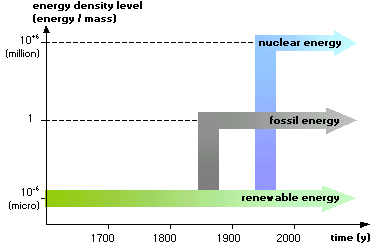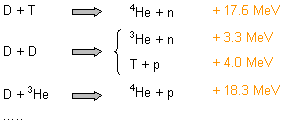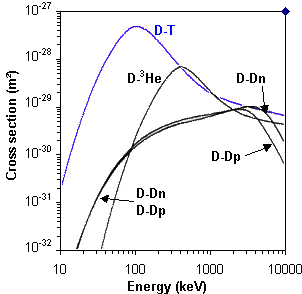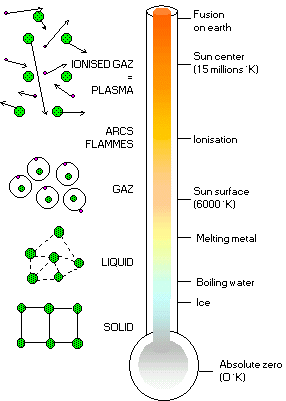|
Introduction
1
- Diversifying energy sources
In 2050 energy consumption could reach two or three times current consumption (energy sources). The fact that fossil fuels are running out, and that it is difficult to adapt renewable energy sources to centralised energy production that is capable of providing for densely populated areas or countries, make the development of new energy sources indispensable. These new forms of energy should obviously meet economic requirements but also take into account environment, operational safety and resource availability requirements. Energy from fusion meets all these requirements.
2
-
From renewable to nuclear power
|
The increase in energy needs has led to the use of energy sources able to supply a greater quantity of energy for a given mass of matter (we then talk in terms of energetic density). The chemical reactions involve phenomena that take place at the level of electrons
 . The energy under consideration is then millions of times lower than that involved in reactions involving the kernel of the atom (nuclear reactions . The energy under consideration is then millions of times lower than that involved in reactions involving the kernel of the atom (nuclear reactions  ). ).
|

|
To produce energy, it is necessary to carry out a transformation in which, between the initial and final state, a small proportion of the body mass involved disappears. This mass
defect may then be found in the form of energy through the well-known formula E=mc2, where E is the energy produced, m the mass that has disappeared and c the speed of light. Two main types of nuclear reaction, which lower mass and therefore release energy, are possible:
-
From
joining very light atomic nuclei (examples; deuterium and tritium) to build heavier atoms
through the process called fusion.
-
From
splitting the nucleus of a sufficiently heavy atom (such as the uranium atom) to make lighter atoms,
through the process called fission.
|
Fusion of two light
nuclei |
Fission of a heavy nucleus |
3
-
Fusion reactions
|
To obtain a fusion reaction, we must bring two
nuclei sufficiently close together for them to repel each other, as they are both charged positively. A certain amount of energy is therefore vital to cross this barrier and arrive in the zone, extremely close to the
nucleus, where there are the nuclear forces capable of getting the better of electrostatic repulsion. The probability of crossing this barrier may be quantified by the " effective cross section". The variation against interaction energy expressed in keV of effective cross sections of several fusion reactions is shown on the graph opposite.

The most accessible fusion reaction is the reaction involving deuterium and tritium. It is on this reaction that research on controlled fusion is conducted.
|


|
|
The temperatures (which measure interaction energy) required for thermonuclear fusion are greater than a hundred million degrees! At such temperatures, electrons are completely detached from the
nucleus; we say that the atom ionises and that we then enter the fourth state of matter, the state of plasma. Plasma exists in the universe in various forms and with very variable characteristics. Thus temperatures go from one to ten thousand electronvolts and densities range even more widely, going from a few particles per m³ in interstellar gas, up to 1030 particules per m³ in the centre of certain stars. Plasma is the most widespread form of matter in the universe.
|

|
|
|